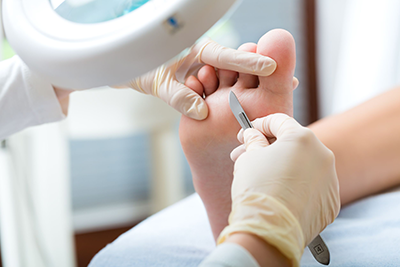Stress FracturesAlso known as a hairline fracture, is a fatigue-induced fracture of the bone caused by repeated stress over time. Instead of resulting from a single severe impact, stress fractures are the result of accumulated trauma from repeated submaximal loading, such as running or jumping. Because of this mechanism, stress fractures are common overuse injuries in athletes.
Stress fractures can be described as a very small sliver or crack in the bone; and are sometimes referred to as "hairline fractures". Stress fractures most frequently occur in weight-bearing bones, such as the tibia (bone of the lower leg), metatarsals, and navicular bones (bones of the foot). Less common are fractures to the femur, pelvis, and sacrum. SIGNS AND SYMPTOMS
Stress fractures most commonly present as pain with weight bearing that increases with exercise or activity. The pain usually subsides with rest but may be constantly present with a more serious bone injury. There is usually an area of localized tenderness on or near the bone and generalized swelling to the area. Percussion or palpation to the bone may reproduce symptoms. CAUSES
Bones are constantly attempting to remodel and repair themselves, especially during a sport where extraordinary stress is applied to the bone. Over time, if enough stress is placed on the bone that it exhausts the capacity of the bone to remodel, a weakened site—a stress fracture—on the bone may appear. The fracture does not appear suddenly. It occurs from repeated traumas, none of which is sufficient to cause a sudden break, but which, when added together, overwhelm the osteoblasts that remodel the bone. Stress fractures commonly occur in sedentary people who suddenly undertake a burst of exercise (whose bones are not used to the task). They may also occur in athletes completing high volume, high impact training, such as running or jumping sports. Stress fractures are also commonly reported in soldiers who march long distances. Muscle fatigue can also play a role in the occurrence of stress fractures. In a runner, each stride normally exerts large forces at various points in the legs. Each shock—a rapid acceleration and energy transfer—must be absorbed. Both muscles and bones serve as shock absorbers. However, the muscles, usually those in the lower leg, become fatigued after running a long distance and lose their ability to absorb shock. As the bones now experience larger stresses, this increases the risk of fracture. Previous stress fractures have been identified as a risk factor. DIAGNOSIS
X-rays usually do not show evidence of new stress fractures, but can be used several weeks after onset of pain when the bone begins to remodel. A CT scan, MRI, or 3-phase bone scan may be more effective for early diagnosis. MRI appears to be the most accurate test. PREVENTION
One method of avoiding stress fractures is to add more stress to the bones. Though this may seem counter-intuitive (because stress fractures are caused by too much stress on the bone), moderate stress applied to the bone in a controlled manner can strengthen the bone and make it less susceptible to a stress fracture. An easy way to do this is to follow the runner's rule of increasing distance by no more than 10 percent per week. This allows the bones to adapt to the added stress so they are able to withstand greater stress in the future. Strengthening exercises also help build muscle strength in the legs. Strengthening these muscles will prevent them from becoming fatigued quickly, allowing them to absorb the strain of running for longer periods of time. Key muscles that need strengthening with lower leg stress fractures are the calves and the shin muscles. Runners often suffer from overuse injuries or repetitive stress injuries. These include stress fractures, stress reactions, tendinitis, meniscal tears, ITB Friction syndrome, and exacerbation of pre-existing arthritis. Stress fractures, if not diagnosed and treated, can develop into complete fractures. Depending on a variety of factors (including weight, running surface and shoe durability), runners should replace their shoes every 300–700 miles to allow adequate mid-sole cushioning. A change in running surfaces can also help prevent stress fractures. However, it is also argued that cushioning in shoes actually causes more stress by reducing the body's natural shock-absorbing action, increasing the frequency of running injuries. During exercise that applies more stress to the bones, it may help to increase calcium and vitamin D intake, depending on the individual. Also, it is important to monitor diet, because nutrition plays a vital role in bone development. Some individuals are at risk of osteoporosis, and depending on the country in which medical care is being supplied, there may be an osteoporosis screening program available. TREATMENT
Rest is the only option for complete healing of a stress fracture. The amount of recovery time varies greatly depending upon the location, severity, the strength of the body's healing response and an individual's nutritional intake. Complete rest and a cast or walking boot are usually used for a period of four to eight weeks, although periods of rest of twelve to sixteen weeks are not uncommon for more severe stress fractures. After this period activities may be gradually resumed, as long as the activities do not cause pain. While the bone may feel healed and not hurt during daily activity, the process of bone remodeling may take place for many months after the injury feels healed, and incidences of re-fracturing the bone are still at significant risk. Activities such as running or sports that place additional stress on the bone should only gradually be resumed. One general rule is to not increase the volume of training by more than 10 percent from one week to the next. Rehabilitation usually includes muscle strength training to help dissipate the forces transmitted to the bones. Bracing or casting the limb with a hard plastic walking boot or air cast may also prove beneficial by taking some stress off the stress fracture. An air cast has pre-inflated cells that put light pressure on the bone, which promotes healing by increasing blood flow to the area. This also reduces pain because of the pressure applied to the bone. If the stress fracture of the leg or foot is severe enough, crutches can help by removing stress from the bone. With severe stress fractures, surgery may be needed for proper healing. The procedure may involve pinning the fracture site, and rehabilitation can take up to six (6) months. |
Additional Services |
Additional Conditions and Treatments
Book Your Appointment Today |









